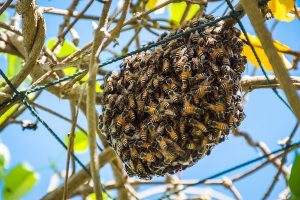Should You Catch A Small Swarm?

Swarming is an essential part of the reproductive life cycle of the honey bee, and it’s a pretty common phenomenon that takes place in most honey bee colonies every year. To know the right answer to “should you catch a small warm,” you need to develop a basic understanding of swarming first. Consider checking out this post till the end so that you can extract the right answer to your query and make the most out of beekeeping.

An Introduction to Swarming
It’s crucial to understand that “swarm” doesn’t refer to the plural for many honeybees, like a “fleet or armada” or a “school of fish.” In actuality, it’s the terminology used to define a grouping of honeybees that has split off from a strong “mother colony” lately with the aim of starting a new hive. Ironically, bee swarms act as both a blessing and a curse to beekeepers.
When they migrate from somewhere else, swarms are synonymous with blessing. On the other hand, they may look like a curse when they leave their parent colony, i.e., your hive.
Should You Catch a Small Swarm?
Certainly, you won’t like the fact that your beloved bees are leaving their bee hive and attempting to build another nest, would you?! Therefore, be it a huge swarm or a small one, you should and must catch it and reinstall it in your own hive. But remember, the job is not at all easy and risk-free as bees hate intruders! While catching and reinstalling a beehive, they will clearly feel badly disturbed, and they won’t show mercy in stinging you.
Thus, it’s more than important to know the right hacks of catching bee swarms so that you can do this messy task with safety and convenience.
Best Ways to Catch Bee Swarms
There are two different methods that beekeepers can employ for catching a bee swarm. While the first one boasts a more laid-back approach and lesser preplanning, the other requires timely participation. Let’s delve deeper and take a look at each of them!
- Catching swarms using traps and bait hives
Using this method, beekeepers can set up several swarm traps near the apiary. Constructed in several different ways, these boxed traps can be left in place all season. The busy beekeepers who find it difficult to keep a consistent eye on the hives can adopt this methodology for catching swarms. However, the only drawback of swarm traps is you may often end up catching a few wild bees, which could introduce some sort of new genetics to your apiary.
- Transition swarms
Another effective measure to catch swarms is catching them in their transition spot. When a honeybee swarm leaves its parent colony, they usually gather somewhere nearby and make that place their go-to resting place. However, they don’t stay in their transition place for more than a few hours. Beekeepers need to utilize this moment of opportunity to catch bee swarms easily.
When should you look for swarms?
You can look for a honeybee swarm during the warmer months of March to June. Expert beekeepers say that spring is the best season to find and catch bee swarms as bees prefer to choose this time for colony build-up. Besides, spring swarms tend to hold the finest ability of “survival of the fittest” due to abundant pollen and nectar.
Talking about the best hours of catching swarms, undoubtedly, it’s afternoon. In sunny afternoons, the queen bee and around 50% of the workers leave their colony to build up a new nest. Any casual observer may find the parent colony empty then; however, the reality differs. The original hive still holds queen cells, one of which later becomes the new queen of the colony.
How to catch a tree swarm?
Bee swarms love greens, and due to this reason, it’s quite common to find small or huge bee swarms in trees. When it comes to catching them, trust me, it’s a lot of fun. However, probability doesn’t work here, and success is directly proportional to your patience and luck.
To elaborate, when a swarm leaves your hive, it may settle down in a close to the ground, small tree. Similarly, it may choose a massively tall SweetGum tree that stands about 30-40 feet up in the air. This is where luck plays the role, as hopefully, you won’t put your life at risk in the trail of reaching bees that are dangerously high up.
Now talking about the method, you can place an empty hive box with a bottom board on the ground under the swarm. You need to take care of the hive top – it should be off but close by. You can also remove around half of the frames to give bees more space.
Give the limb a vigorous shake and let the bees fall in or near the box. When the queen bee falls in the box, others will follow her blindly. After the initial shake, you can put the remaining frames inside the box and place the top back on. In case the rest of the swarms don’t hit inside the box in the next 15-20 minutes, you need to understand that the queen bee hasn’t fallen into your trap. So, go for shaking the tree again.
This “shake ’em “method won’t hurt your bees; however, the probability is high that you will be stung by the bees because you have attempted the unforgivable crime of disturbing those peaceful, stingy creatures.
Takeaways
Keeping the risk in mind, it’s always a wise idea to wear protective bee suit while executing the highly funny yet wildly adventurous task of catching bee swarms both small and big. Hope you have enjoyed grabbing the shared information. Be well and enjoy blissful and safe beekeeping!





